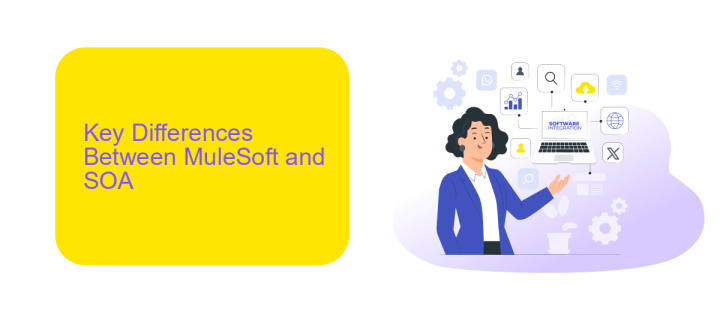MuleSoft Vs SOA
In today's rapidly evolving technological landscape, integration platforms play a crucial role in ensuring seamless connectivity between diverse systems. MuleSoft and Service-Oriented Architecture (SOA) are two prominent solutions in this domain. This article delves into a comparative analysis of MuleSoft and SOA, exploring their core features, benefits, and how they cater to the ever-growing demands of modern enterprises.
Definition of MuleSoft and SOA
MuleSoft is a software company that provides integration software for connecting applications, data, and devices. Its flagship product, Anypoint Platform, enables businesses to design, build, and manage APIs and integrations in a unified manner. MuleSoft facilitates seamless communication between different systems, making it easier to automate workflows and enhance operational efficiency.
- Anypoint Platform: A comprehensive suite for API management and integration.
- API Designer: Tools for designing and testing APIs.
- API Manager: Features for managing and securing APIs.
- Integration Solutions: Pre-built connectors for various systems and applications.
Service-Oriented Architecture (SOA) is a design principle where services are provided to other components by application components through a communication protocol over a network. SOA allows for the reuse of existing services and promotes interoperability between disparate systems. Tools like ApiX-Drive can complement SOA by providing easy-to-use integration services that automate data transfer between different platforms, enhancing the overall efficiency of SOA implementations.
Key Differences Between MuleSoft and SOA

MuleSoft is a comprehensive integration platform that provides tools for connecting applications, data, and devices through APIs. It offers a unified solution for API management, design, and implementation, making it a robust choice for modern integration needs. MuleSoft's Anypoint Platform allows for seamless connectivity across various systems, enabling businesses to build application networks that are scalable and secure. In contrast, Service-Oriented Architecture (SOA) is a design principle that structures software as a collection of services. SOA emphasizes reusability and interoperability, often using web services to facilitate communication between different applications.
While both MuleSoft and SOA aim to streamline integration processes, MuleSoft offers a more comprehensive suite of tools and services, including real-time analytics and API lifecycle management. SOA, on the other hand, provides a more generalized framework for service interaction without the specialized tools found in MuleSoft. For businesses looking to automate and integrate various systems effortlessly, services like ApiX-Drive can complement both MuleSoft and SOA by providing easy-to-use integration solutions that require minimal coding and setup.
Advantages of MuleSoft Over SOA

MuleSoft offers several advantages over traditional Service-Oriented Architecture (SOA) frameworks. Firstly, MuleSoft provides a more modern, scalable, and flexible integration platform that is designed to handle the complexities of today's digital ecosystems. Unlike SOA, which often requires extensive custom coding, MuleSoft's Anypoint Platform offers a more user-friendly interface and robust set of pre-built connectors that streamline the integration process.
- Ease of Use: MuleSoft's drag-and-drop interface simplifies the integration process, making it accessible even to non-developers.
- Scalability: MuleSoft is built to handle high volumes of transactions, making it ideal for enterprises looking to scale their operations.
- API Management: MuleSoft provides comprehensive API management capabilities, including design, deployment, and monitoring, which are often lacking in traditional SOA frameworks.
- Pre-built Connectors: With a wide range of pre-built connectors, including those for ApiX-Drive, MuleSoft significantly reduces the time and effort required to integrate various systems.
- Cloud Compatibility: MuleSoft is cloud-native, offering seamless integration with cloud services and on-premises systems alike.
Overall, MuleSoft's modern approach to integration, combined with its user-friendly tools and extensive connector library, offers a more efficient and scalable solution compared to traditional SOA frameworks. This makes it an ideal choice for businesses looking to streamline their integration processes and improve operational efficiency.
Advantages of SOA Over MuleSoft

Service-Oriented Architecture (SOA) offers several advantages over MuleSoft, particularly in terms of flexibility and interoperability. SOA's modular approach allows for easier integration of diverse systems and technologies, providing a more adaptable framework for evolving business needs.
One of the key benefits of SOA is its ability to facilitate seamless communication between disparate applications through standardized protocols. This ensures that different services can work together efficiently without the need for extensive custom coding.
- Greater flexibility in integrating varied systems
- Enhanced interoperability through standardized protocols
- Scalability to meet growing business demands
- Cost-effective maintenance and updates
In addition, platforms like ApiX-Drive further enhance SOA's capabilities by streamlining the integration process. ApiX-Drive simplifies the connection between various applications, reducing the complexity and time required for setup. This makes SOA a robust choice for businesses seeking efficient and scalable integration solutions.
Conclusion
In conclusion, both MuleSoft and SOA offer robust solutions for integrating various services and applications within an enterprise environment. MuleSoft provides a more modern, API-led approach that simplifies the integration process and enhances scalability. On the other hand, SOA focuses on a more traditional, service-oriented architecture that ensures reusability and interoperability of services across different platforms.
When choosing between MuleSoft and SOA, it's crucial to consider your organization's specific needs and existing infrastructure. Tools like ApiX-Drive can further streamline the integration process by offering automated workflows and seamless data synchronization between services. Ultimately, the decision should be guided by the desired level of flexibility, ease of use, and the long-term goals of your integration strategy.
FAQ
What is the main difference between MuleSoft and traditional SOA?
Can MuleSoft replace an existing SOA infrastructure?
How does MuleSoft handle API management compared to SOA?
Is MuleSoft more suitable for cloud-based integrations than SOA?
What are some tools or services that can help with the integration process?
Time is the most valuable resource for business today. Almost half of it is wasted on routine tasks. Your employees are constantly forced to perform monotonous tasks that are difficult to classify as important and specialized. You can leave everything as it is by hiring additional employees, or you can automate most of the business processes using the ApiX-Drive online connector to get rid of unnecessary time and money expenses once and for all. The choice is yours!

